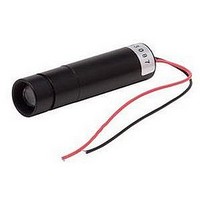150C-3-650 BEA ELECTRO SALES, 150C-3-650 Datasheet - Page 7

150C-3-650
Manufacturer Part Number
150C-3-650
Description
MODULE, LASER, 650NM, 1MM, 3mW
Manufacturer
BEA ELECTRO SALES
Datasheet
1.BEA-220.pdf
(8 pages)
Specifications of 150C-3-650
Wavelength Typ
650nm
Output Power
3mW
Laser Lens
Glass
Voltage Rating
9V
Laser Class
Class IIIA
Power Rating
3mW
Peak Reflow Compatible (260 C)
No
Current Rating
30mA
Size
12 X 50 Mm
Leaded Process Compatible
No
Rohs Compliant
No
Lead Free Status / RoHS Status
Contains lead / RoHS non-compliant
W
LASER is an acronym which stands for Light Amplification by
Stimulated Emission of Radiation. The energy generated by the laser
is in or near the optical portion of the electromagnetic spectrum (see
Figure 1). Energy is amplified to extremely high intensity by an atom-
ic process called stimulated emission. The color of laser light is nor-
mally expressed in terms of the laser’s wavelength. Nanometer (nm)
is the most common unit used in expressing a laser’s wavelength.
L
The laser p
If directed, reflected, or focused upon an object, laser light will be
partially absorbed, raising the temperature of the surface and/or the
interior of the object, potentially causing an alteration or deforma-
tion of the material. Lasers can also cause tissue damage. Today, most
high-power lasers are designed to minimize access to laser radiation
during normal operation. Lower-power lasers may emit levels of laser
light that are not a hazard.
L
The Center for Devices and Radiological Health, a division of the
Food and Drug Administration regulates the manufacturing and
classification of laser products. The laser classes help group lasers
by their hazard potential, and identifies these classes based on their
optical emission (wavelength, exposure time, output power).
G
CW L
Class I Lasers or laser systems
operating conditions, pose a hazard.
Class IIa Low power visible lasers or laser systems that are not
intended for prolonged viewing, and under normal operating
conditions will not produce a hazard if the beam is viewed directly
for periods not exceeding 1000 seconds.
Class II Low power visible lasers or laser systems which, because
of the normal human aversion response, do not normally present a
hazard, but may present some potential for hazard if viewed directly
for extended periods of time (like many conventional light sources).
Class IIIa Lasers or laser systems having a CAUTION label that
normally would not injure the eye if viewed for only momentary
periods (within the aversion response period) with the unaided
eye, but may present a greater hazard if viewed using collecting
optics. Another group of Class 3a lasers have DANGER labels and
are capable of exceeding permissible exposure levels for the eye
in 0.25 seconds and still pose a low risk of injury.
Figure 1: The optical spectrum. Laser light is nonionizing and ranges from the
ultra-violet (100 - 400nm), visible (400 - 700nm), and infrared (700nm - 1mm).
Note: The data and dimensions contained in this catalog are intended for use as a guide and are subject to change and/or update by BEA Electro Sales, Inc. without
notice. Every care has been taken to ensure that the information contained within this catalog is accurate from the date of publication. BEA Electro Sales will not
accept responsibility for damage, loss, or expense resulting from any error or omission contained herein. Furthermore, all products are sold with the understanding
that users will perform all necessary tests to determine the suitability of these products for their intended use.
0.1 nm
ASER
ASER
X-RAYS
ENERAL
1A
HAT IS A
ASER
H
H
roduces an intense, highly directional beam of light.
1 nm 0.1 mm nm
10A 100 nm 200
AZARDS
AZARDS
G
L
C
UIDELINES FOR
ULTRAVIOLET
ASER
LASSIFICATION
& B
C
?
LASSIFICATION
EAM
300
nm
that do not, under normal
400 500
H
nm
AZARDS
nm
VISIBLE
600
nm
700
nm
NEAR-INFRARED
800
nm
Class IIIb Lasers or laser systems that can produce a hazard if viewed
directly. This includes intrabeam viewing of specular reflections. Class
3B lasers will not normally produce a hazardous diffuse reflection.
Class IV Lasers or laser systems that produce a hazard not only from
direct or specular reflections, but may also produce hazardous
diffuse reflections. Such lasers may produce significant skin hazards
as well as fire hazards.
The information mentioned here is intended to be an introduction
to lasers and laser safety, and should not be considered to be an
authoritarian guide. A better informed user has the knowledge to
make safer decisions: learn about safety procedures for your class
of laser, and the next class higher.
An excellent source for laser safety is the Laser Institute of America.
A very useful resource is their web-based Safety Bulletin and printed
Laser Safety Guide.
L
Term
Angstrom
Beam Diameter
Beam Divergence
CDRH
CW
LASER
Laser Diode Module Small semiconductor laser packaged
Micron
Milli
Millimeter
MRad
Nanometer
Watt
Wavelength
900 1000 nm 3 µm
BEA Lasers is a Corporate Member of the Laser Institute of America.
nm
ASER
1 µm
D
IODE
M
MID-INFRARED
Definition
Metric unit equal to 10
Calculated distance between two exactly
opposed points on a beam at a chosen
fraction of peak power.
Increase in the diameter of an initially
collimated beam as measured in
milliradians (mrad) at specified points.
Center for Devices and Radiological Health.
Continuous Wave.
Light Amplification by Stimulated Emission
of Radiation.
in a durable housing.
One-millionth of a meter (1µm = 10
Prefix for one-thousandth (10
0.001 meter.
Milli-Radian; 1/1000 of a radian used to
specify laser beam divergence.
One-billionth of a meter (1nm = 10
Unit of power that produces energy
at the rate of 1 joule per second.
Electromagnetic energy transmitted
in the form of a sinusoidal wave;
the physical distance covered by one
cycle of this wave. Wavelength is inversely
proportional to frequency.
ODULE
G
LOSSARY
30 µm
-10
meter.
FAR-INFRARED
-3
).
1000 µm (1mm)
-9
-6
m).
m).









